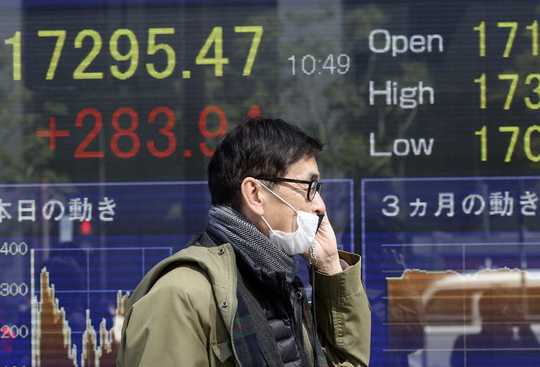 Economists are using models to try to determine what short- and long-term impacts the coronavirus pandemic will have on the global economy. (AP Photo/Koji Sasahara)
Economists are using models to try to determine what short- and long-term impacts the coronavirus pandemic will have on the global economy. (AP Photo/Koji Sasahara)
Predictions about the effects of the coronavirus pandemic on the world’s economy arrive almost daily. How can we make sense of them in the midst of this economic storm? After all, research shows that economic forecasts made during events such as SARS are often wildly inaccurate.
To calibrate current forecasts — such as the International Monetary Fund’s prediction of a 6.2 per cent decline in Gross Domestic Product for Canada — I’ve looked at the history of similar worldwide economic shocks, studied macroeconomics models and reviewed nearly 75 studies to better understand what might happen in a post-pandemic world.
The economic effects of 1918-20 flu
The influenza outbreak of 1918-20 killed at least 40 million people, or approximately two per cent of the world’s population. In Canada alone, at least 50,000 deaths were attributed to the flu, approaching the number of Canadian deaths in the First World War. Solid data about GDP did not exist for that era, so economic historians have to recreate economic measurements based on the data that was collected.
The most thorough study focuses on how the influenza pandemic 100 years ago affected Sweden. The Swedish study took advantage of the fact that the country kept very detailed data on causes of death, as well as having a history of accurate economic record-keeping dating back to the 1800s.
Sweden was a neutral country in the First World War, so unlike other Western nations, the war had limited impact on the country’s economy. The fatality rate from the flu in Sweden was comparable to most Western nations and its economy was similar to other developed countries.
The study of Sweden’s flu experience a century ago suggests there could be permanent negative long-term economic effects from the current pandemic. There was a decline in income from capital sources such as interest, dividends and rents of five per cent that lasted at least until 1929. This was a permanent decline not recovered once the flu pandemic passed.
Swedish poor never recovered
There was also an increase in absolute poverty for those Swedes at the bottom of the economic pyramid: enrolment in government-run “poorhouses” in higher flu-incidence regions jumped 11 per cent and did not decline over the next decade. There was some good news: while employment income was reduced during the crisis, it quickly rebounded to predicted normal levels.
A recent study attempts to measure the effects of the influenza on 1918-21 GDP. Harvard economist Robert Barro and his colleagues painstakingly put together a set of economic data that attempts to recreate what GDP in 42 countries would have been.
They have found that the flu was responsible for an additional six per cent decline in global GDP. The study concludes that the effects were reversed by 1921. This estimate of the flu’s historical GDP effects is strikingly similar to the IMF’s current prediction of six per cent reduction in GDP for Western economies as a result of the coronavirus pandemic.
Modelling economic effects of a pandemic
Beyond economic history, we can look at macroeconomic models of the global, regional or national economies that run scenarios about pandemic economic shocks.
One scenario by British economists and health science academics is particularly apt in light of COVID-19.
Their scenario models virus incidence and fatality rates close to the current best estimates and includes strong and early social distancing measures such as school closures and work-from-home arrangements that we see today in many countries fighting the pandemic.
Their model estimates a 21 per cent decline in U.K. GDP in the first full quarter of the pandemic, with a 4.45 per cent decline in GDP for first year. The model also suggests the time frame to economic recovery is about two years. The current IMF projection for the U.K. is a 6.5 per cent decline in annual GDP.
There is no doubt that COVID-19 is a major shock to the global economy. Across all the studies I reviewed, the conclusion of a significant decline in GDP in the order of 4.5 to six per cent with full recovery within two years seems to be well justified.
 Men wear masks in Alberta during the influenza pandemic of 1918. Second and third waves of the flu added to economic woes in the early 20th century. THE CANADIAN PRESS/National Archives of Canada
Men wear masks in Alberta during the influenza pandemic of 1918. Second and third waves of the flu added to economic woes in the early 20th century. THE CANADIAN PRESS/National Archives of Canada
The economic history of the influenza pandemic 100 years ago suggests early easing of social distancing measures and the inability to develop an effective vaccine contributed to second and third flu waves. These waves might have greater effects on the modern service-based economy of Western nations than they did on the more agrarian economy of 100 years ago.
Economic history serves as a potential warning that the economy could get much worse if these measures are ignored.
It’s important to remember that GDP is a marker of a nation’s overall economic health. On an individual level, the effects may be more far-reaching and painful. There are financial and professional losses that may never be recovered.
The 1918-20 flu offers an important history lesson for the world’s current economic outlook: there may be significant declines in the returns to capital in the next decade, as well as relative increases in poverty for the neediest in our society.![]()
About The Author
Steven E. Salterio, Stephen JR Smith Chair of Accounting and Auditng, Professor of Business, Queen's University, Ontario
This article is republished from The Conversation under a Creative Commons license. Read the original article.
Recommended books:
Capital in the Twenty-First Century
by Thomas Piketty. (Translated by Arthur Goldhammer)
 In Capital in the Twenty-First Century, Thomas Piketty analyzes a unique collection of data from twenty countries, ranging as far back as the eighteenth century, to uncover key economic and social patterns. But economic trends are not acts of God. Political action has curbed dangerous inequalities in the past, says Thomas Piketty, and may do so again. A work of extraordinary ambition, originality, and rigor, Capital in the Twenty-First Century reorients our understanding of economic history and confronts us with sobering lessons for today. His findings will transform debate and set the agenda for the next generation of thought about wealth and inequality.
In Capital in the Twenty-First Century, Thomas Piketty analyzes a unique collection of data from twenty countries, ranging as far back as the eighteenth century, to uncover key economic and social patterns. But economic trends are not acts of God. Political action has curbed dangerous inequalities in the past, says Thomas Piketty, and may do so again. A work of extraordinary ambition, originality, and rigor, Capital in the Twenty-First Century reorients our understanding of economic history and confronts us with sobering lessons for today. His findings will transform debate and set the agenda for the next generation of thought about wealth and inequality.
Click here for more info and/or to order this book on Amazon.
Nature's Fortune: How Business and Society Thrive by Investing in Nature
by Mark R. Tercek and Jonathan S. Adams.
 What is nature worth? The answer to this question—which traditionally has been framed in environmental terms—is revolutionizing the way we do business. In Nature’s Fortune, Mark Tercek, CEO of The Nature Conservancy and former investment banker, and science writer Jonathan Adams argue that nature is not only the foundation of human well-being, but also the smartest commercial investment any business or government can make. The forests, floodplains, and oyster reefs often seen simply as raw materials or as obstacles to be cleared in the name of progress are, in fact as important to our future prosperity as technology or law or business innovation. Nature’s Fortune offers an essential guide to the world’s economic—and environmental—well-being.
What is nature worth? The answer to this question—which traditionally has been framed in environmental terms—is revolutionizing the way we do business. In Nature’s Fortune, Mark Tercek, CEO of The Nature Conservancy and former investment banker, and science writer Jonathan Adams argue that nature is not only the foundation of human well-being, but also the smartest commercial investment any business or government can make. The forests, floodplains, and oyster reefs often seen simply as raw materials or as obstacles to be cleared in the name of progress are, in fact as important to our future prosperity as technology or law or business innovation. Nature’s Fortune offers an essential guide to the world’s economic—and environmental—well-being.
Click here for more info and/or to order this book on Amazon.
Beyond Outrage: What has gone wrong with our economy and our democracy, and how to fix it -- by Robert B. Reich
 In this timely book, Robert B. Reich argues that nothing good happens in Washington unless citizens are energized and organized to make sure Washington acts in the public good. The first step is to see the big picture. Beyond Outrage connects the dots, showing why the increasing share of income and wealth going to the top has hobbled jobs and growth for everyone else, undermining our democracy; caused Americans to become increasingly cynical about public life; and turned many Americans against one another. He also explains why the proposals of the “regressive right” are dead wrong and provides a clear roadmap of what must be done instead. Here’s a plan for action for everyone who cares about the future of America.
In this timely book, Robert B. Reich argues that nothing good happens in Washington unless citizens are energized and organized to make sure Washington acts in the public good. The first step is to see the big picture. Beyond Outrage connects the dots, showing why the increasing share of income and wealth going to the top has hobbled jobs and growth for everyone else, undermining our democracy; caused Americans to become increasingly cynical about public life; and turned many Americans against one another. He also explains why the proposals of the “regressive right” are dead wrong and provides a clear roadmap of what must be done instead. Here’s a plan for action for everyone who cares about the future of America.
Click here for more info or to order this book on Amazon.
This Changes Everything: Occupy Wall Street and the 99% Movement
by Sarah van Gelder and staff of YES! Magazine.
 This Changes Everything shows how the Occupy movement is shifting the way people view themselves and the world, the kind of society they believe is possible, and their own involvement in creating a society that works for the 99% rather than just the 1%. Attempts to pigeonhole this decentralized, fast-evolving movement have led to confusion and misperception. In this volume, the editors of YES! Magazine bring together voices from inside and outside the protests to convey the issues, possibilities, and personalities associated with the Occupy Wall Street movement. This book features contributions from Naomi Klein, David Korten, Rebecca Solnit, Ralph Nader, and others, as well as Occupy activists who were there from the beginning.
This Changes Everything shows how the Occupy movement is shifting the way people view themselves and the world, the kind of society they believe is possible, and their own involvement in creating a society that works for the 99% rather than just the 1%. Attempts to pigeonhole this decentralized, fast-evolving movement have led to confusion and misperception. In this volume, the editors of YES! Magazine bring together voices from inside and outside the protests to convey the issues, possibilities, and personalities associated with the Occupy Wall Street movement. This book features contributions from Naomi Klein, David Korten, Rebecca Solnit, Ralph Nader, and others, as well as Occupy activists who were there from the beginning.
Click here for more info and/or to order this book on Amazon.
























